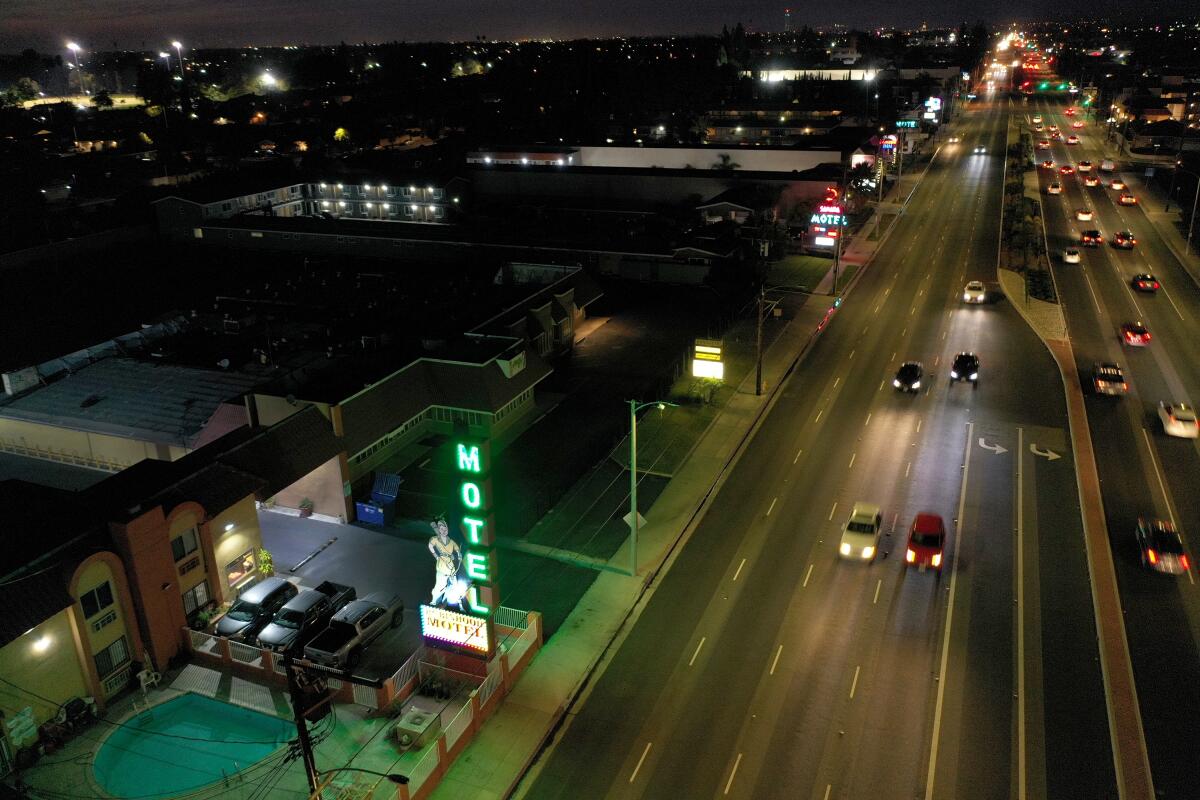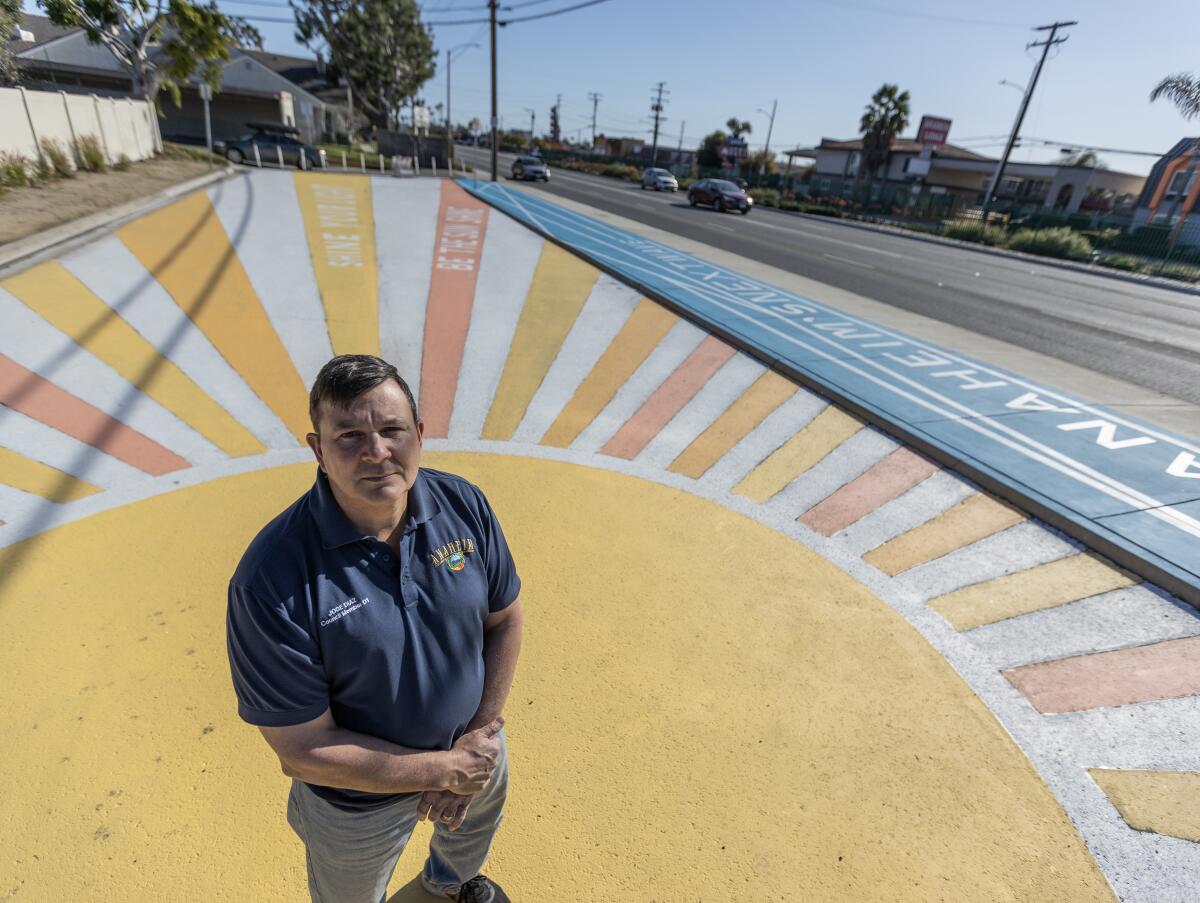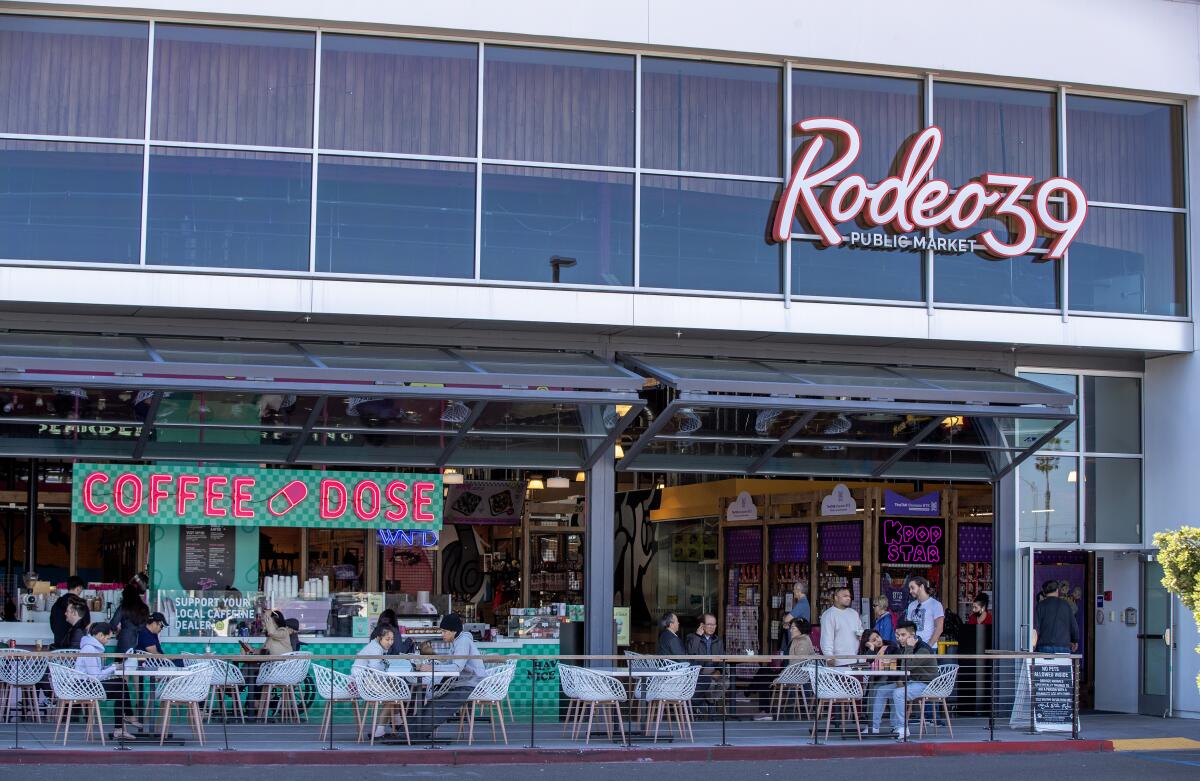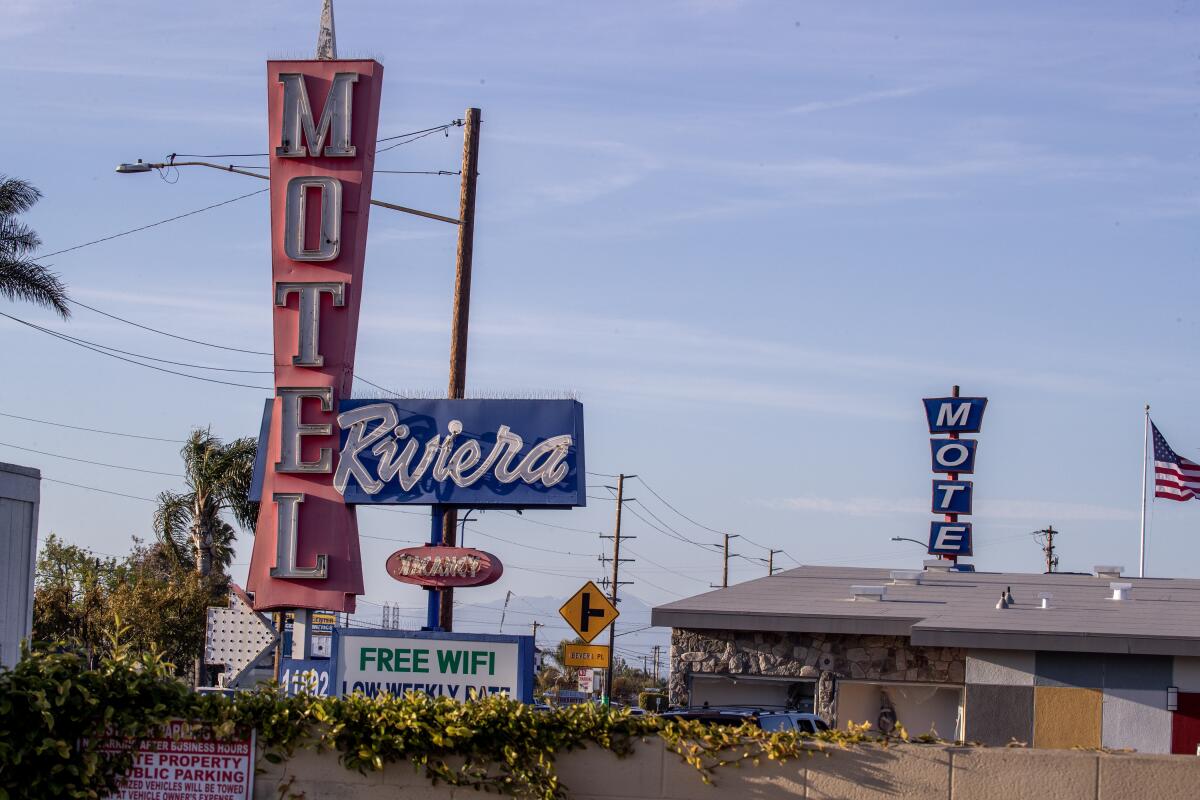Orange County looks to redeem its fabled ‘Road to Summer,’ one seedy motel at a time

- Share via
Jodie Mosley remembers when Beach Boulevard lived up to its reputation as Orange County’s “Road to Summer.”
Starting in the 1950s and for decades after, it was a corridor for locals and tourists in search of good-hearted fun. Families knew it as the gateway to Knott’s Berry Farm in Buena Park, where they could gobble the famous fried chicken and whoop through the thrilling final drop on the Timber Mountain Log Ride. And beachgoers knew it as the most direct route to the sandy shores and celebrated swells of Huntington Beach.
“We had relatives visit from New York and we would go to Knott’s Berry Farm, the California Alligator Farm and the beach together,” said Mosley, 61, a lifelong Anaheim resident. “Driving down Beach, you would see people with surfboards on their cars.”
In the boom years, Beach Boulevard’s drawing power supported dozens of motels that were clean and affordable for families looking to stay a couple nights. Mosley’s grandmother owned a popular one, the Oasis Motel in Anaheim. And her parents ran a family restaurant on the boulevard in neighboring Stanton.
But as Orange County developed, Beach Boulevard fell behind. Small cities grew bigger, adding their own shopping and entertainment districts. New cities sprang up throughout southern Orange County, along with new freeways that offered faster routes for inland residents headed to the beach.
By the 1980s, Beach Boulevard had entered what would be a decades-long descent, its aging neon-lit motels becoming synonymous with prostitution, drug-dealing and cheap long-term rentals for people on the brink of homelessness.

But in recent years, a core of cities along the 21-mile route — Buena Park, Anaheim and Stanton — have begun pouring funding and resources into reimagining Beach Boulevard as a modern destination for Orange County’s flourishing suburbs. The cities are taking distinctly different approaches, but central to the equation for all three is what to do with the dozens of blighted motels along the route.
For cities like Anaheim, rundown motels are a visible — and expensive — obstacle on Beach Boulevard’s road to redemption.
Anaheim City Councilmember Jose Diaz lives near the site of the former Covered Wagon, a red-tagged motel that the city demolished in January after buying it for $6.6 million. Diaz toured its abandoned rooms last year and found the conditions decrepit.
“I saw diaper bags next to drugs,” Diaz said, “and aluminum foil with drugs inside next to baby bottles.”
And police efforts to crack down on the open solicitation of sex and drugs weren’t proving a lasting solution, said Anaheim Police Sgt. Brian Paqua.
“We always tried to clean up Beach Boulevard by just arresting everything that moves out here,” Paqua said in the parking lot of the former Anaheim Lodge. “And that didn’t work.”

Anaheim leaders have taken a multipronged approach to revitalizing the boulevard, spending millions of dollars in recent years to buy up motels and lure new forms of development. With taxpayer funds, the city bought out three motels in the last four years and is negotiating with another motel operator. Anaheim is eyeing the lots for townhomes, apartments and an affordable housing project.
The Covered Wagon is slated to become affordable housing next year, something Diaz sees as a boon to Anaheim’s rebuilding efforts, which includes 39 Commons, a shopping center being raised on a former landfill.
Meanwhile, newly installed cameras with flashing blue lights are proving a deterrent to prostitution and drug-dealing. And brightly colored sidewalk art is giving local residents a reason to visit the corridor.
“We’re starting to see families walk up and down Beach Boulevard again,” Paqua said. “It’s nicer and safer than I’ve seen it in the 21 years I’ve been here with the Police Department.”
The revamp hasn’t come without a fight.
A landslide beneath the historic Casa Romantica in San Clemente underscores the threat of coastal instability exacerbated by last winter’s powerful storms.
After city officials imposed strict operating conditions on the Anaheim Lodge last year, citing concerns about crime, the motel’s owner sued for $20 million and claimed the city targeted his business for renting to homeless people. He dropped the suit after Anaheim completed a $7.6-million purchase of the property. A motel operator across the street is pressing his legal fight on the same grounds.
Despite the progress, another 15 mostly dilapidated motels remain along Anaheim’s 1.5-mile strip of the boulevard. That doesn’t dampen Diaz’s confidence.
“Beach Boulevard is going to be a destination,” Diaz said, “but that ambition cannot be accomplished alone.”

Nearby Stanton is taking a different path forward.
A small working-class city, Stanton is shrugging off its “Crossroads to Vacationland” past that left it a retail ghost town along the highway.
In 2017, Frontier Real Estate Investments acquired a 22-acre business plaza that had been hollowed out to just 10% occupancy. The developers revamped the site into a market-rate condominium project with a novel anchor client: Rodeo 39 Public Market, an eclectic and decidedly modern take on a food court.
The food hall opened in October 2020 and attracts a young crowd from neighboring cities, while also tapping into Stanton’s growing Asian American population. A mix of Asian food stalls, including the county’s only Laotian barbecue eatery, and a K-pop merchandise store, cater to the demographic.
“What’s special about Rodeo 39 is that we’re giving people a reason to stop in Stanton on Beach,” said Tom Carpenter, vice president of acquisitions and leasing for Frontier Real Estate Investments. “We’re changing some of those traffic patterns and making Stanton a destination, not a pass through.”
City officials credit Rodeo 39 as a “catalyst” for the ongoing transformation of its portion of Beach Boulevard. Two luxury apartments are under construction, including one that promises one of the county’s largest rooftop sky decks.

Unlike Anaheim and Buena Park, Stanton has turned to Project Homekey, a multibillion-dollar state effort that provides cities and counties funding to convert underused hotels and motels into permanent housing with supportive services for homeless people.
“It’s a big process, but we’re completely invested,” said City Councilmember Hong Alyce Van. “We have very exciting luxury apartments for folks who are maybe not our typical demographic, but at the same time we don’t want to lose sight of the most vulnerable.”
Three of Orange County’s six Project Homekey sites are in Stanton.
Deborah Kraft stayed at the Stanton Inn and Suites for eight months as part of Project Roomkey, an earlier state-led effort to put vulnerable homeless people in motels during the pandemic, before the motel was slated for permanent conversion. She said she preferred her room’s amenities — two queen-sized beds, a microwave and TV — over a homeless shelter.
“There was all kinds of weird stuff going on inside that motel,” she said. “But at least I had my own room and could close the door.”

A few miles north, Buena Park has centered its redevelopment hopes on Knott’s Berry Farm, the historic theme park that now occupies 57 acres. Though still a draw, with 4.1 million visitors annually, Knott’s share of the national market had fallen out of the top 10 by 1996, a year before Cedar Fair bought the theme park for $300 million.
Cedar Fair has added several thundering thrill rides and continues to invest in the property. Future plans include revamping a pioneering roller coaster and a makeover of the on-site hotel.
With the theme park as an anchor, Buena Park aggressively bought out half a dozen nearby motels and used the space to build an adjacent Vegas-style Entertainment Zone strip that features restaurants and campy dinner theater. The city used redevelopment funds to acquire the motels, before the state dissolved such agencies in 2012.
Saddled with empty lots afterward, the city sold the land at cut-rate prices to lure new attractions. In 2015, Rock & Brews, a national restaurant chain co-founded by members of the rock band KISS, opened at the site of a motel demolished by the city. Two years later, Porto’s Bakery and Café, a popular Cuban American chain, welcomed lines of customers where two other motels formerly stood.
Despite the ambitious revamp, a few lots along the Buena Park strip remain fenced off and undeveloped.
That’s also true in Anaheim. Among them is the site of the Oasis Motel that Mosley’s grandmother operated, which has been vacant since a private owner demolished it in 2002. For Mosley, the weedy lot, still dotted with graceful palm trees, stands as crushing symbol of faded glory and lost opportunities.
“We want Beach Boulevard back, even though it can’t be exactly the same as it was before,” she said.
“It just breaks everybody’s heart that they just haven’t taken care of it with pride.”
- Share via
Watch L.A. Times Today at 7 p.m. on Spectrum News 1 on Channel 1 or live stream on the Spectrum News App. Palos Verdes Peninsula and Orange County viewers can watch on Cox Systems on channel 99.
More to Read
Sign up for Essential California
The most important California stories and recommendations in your inbox every morning.
You may occasionally receive promotional content from the Los Angeles Times.
















